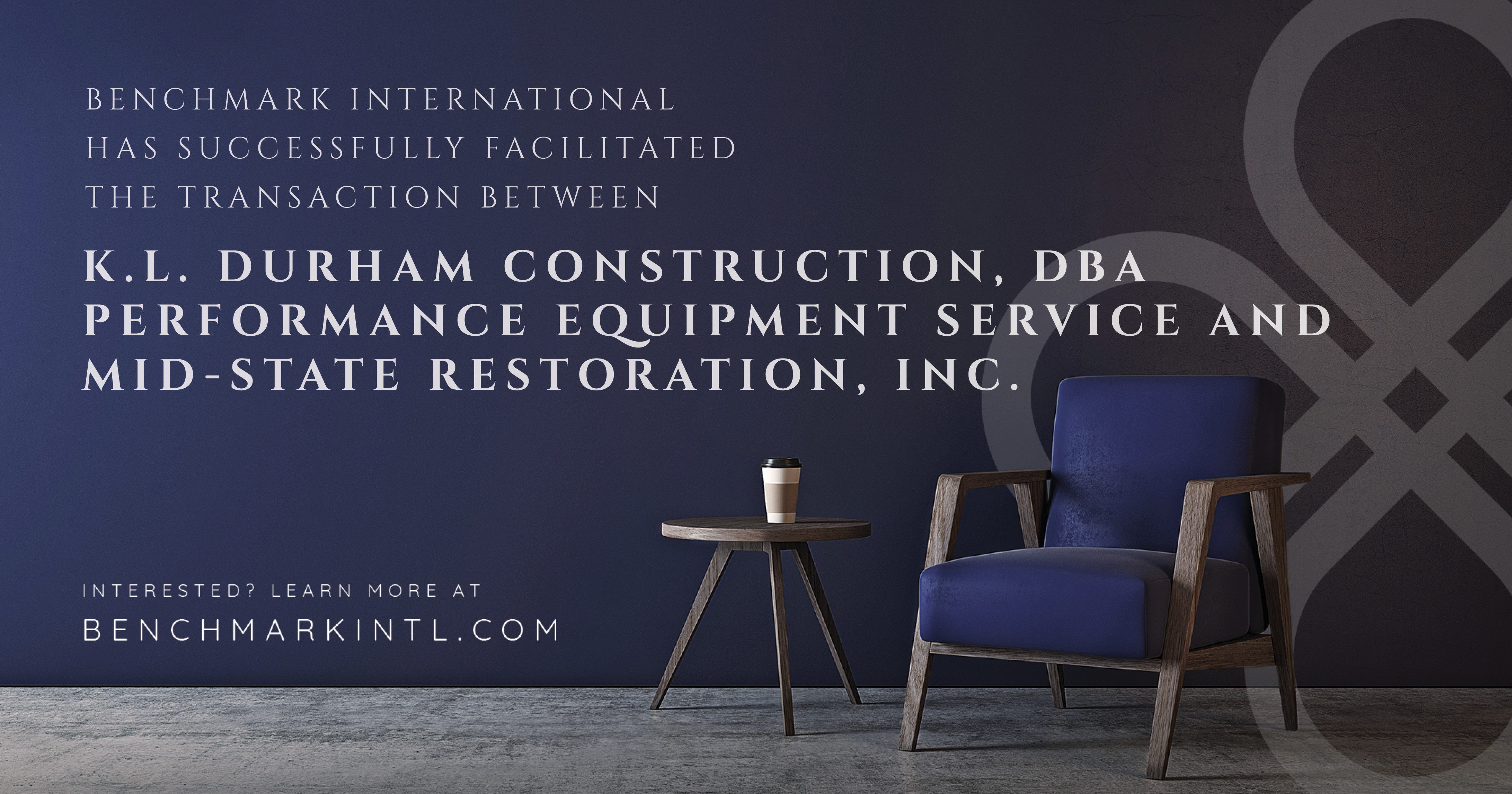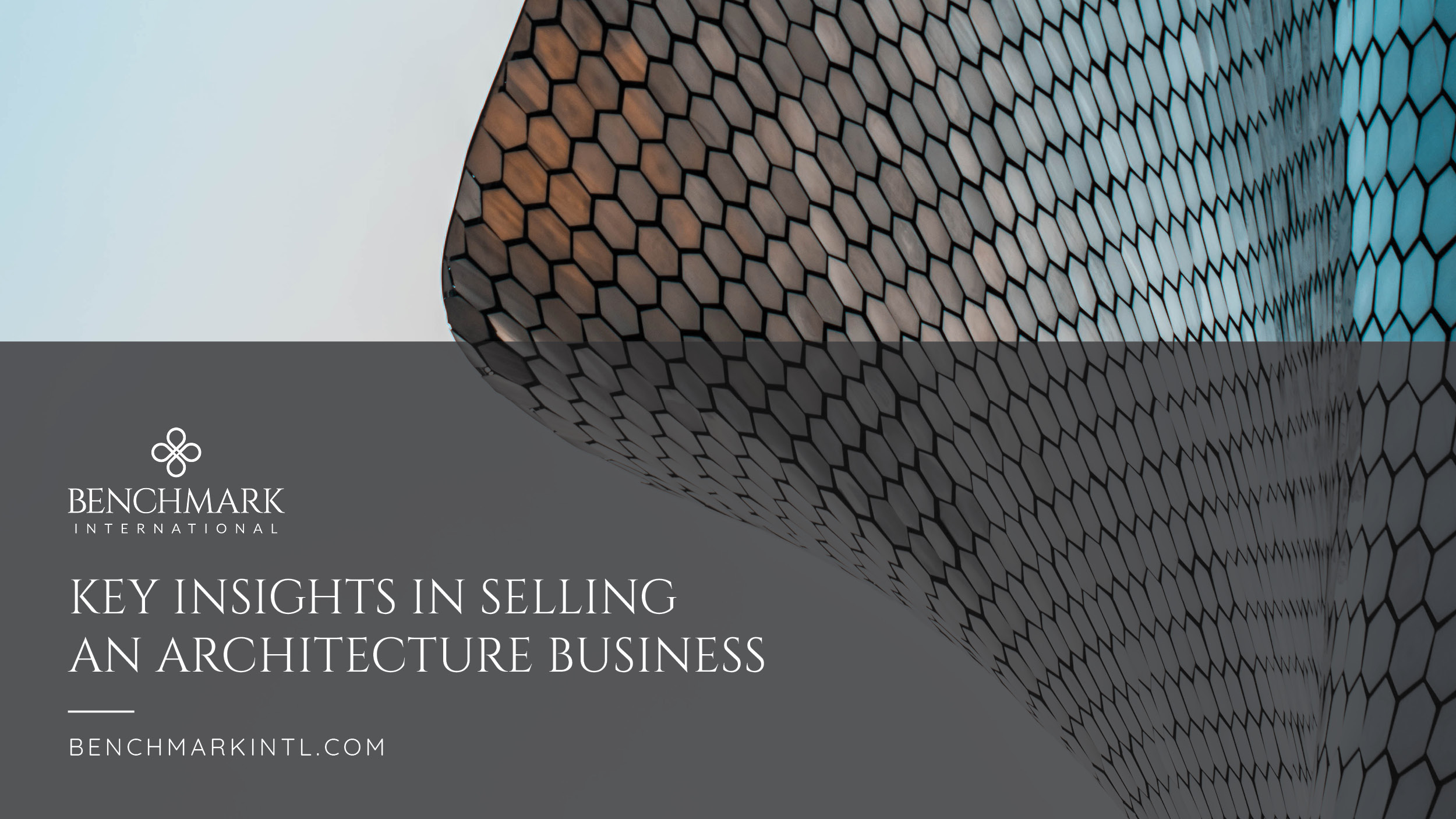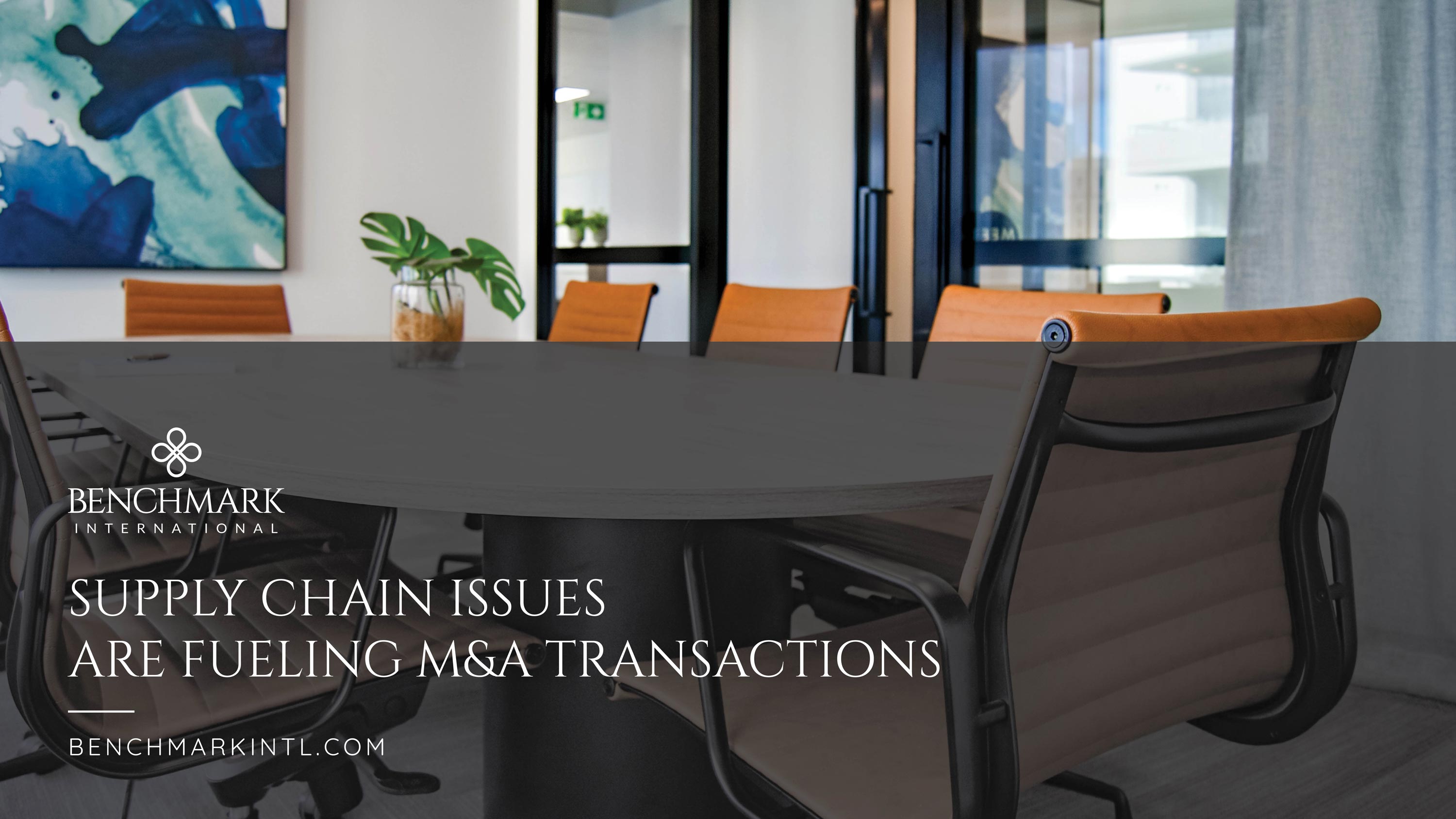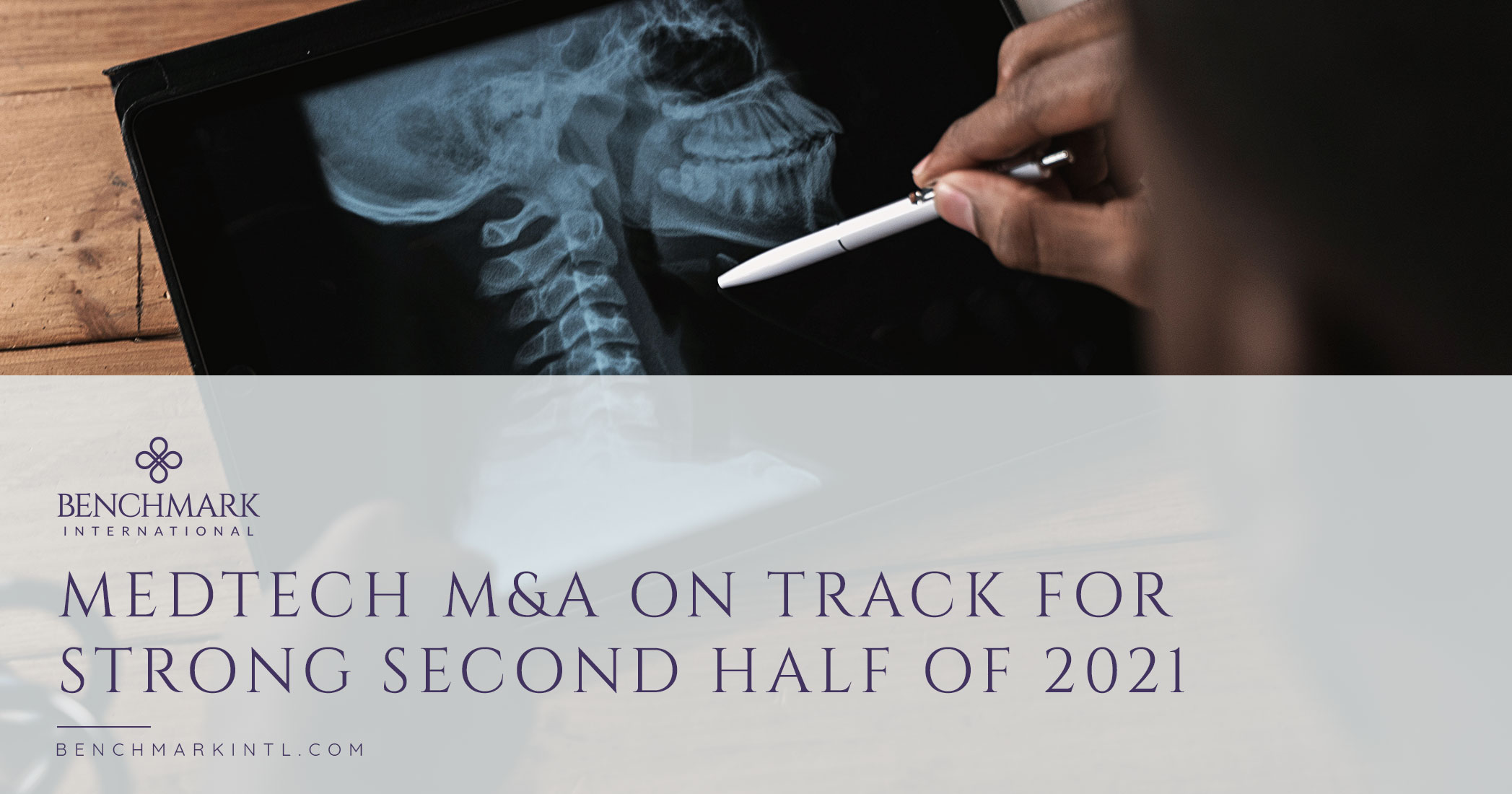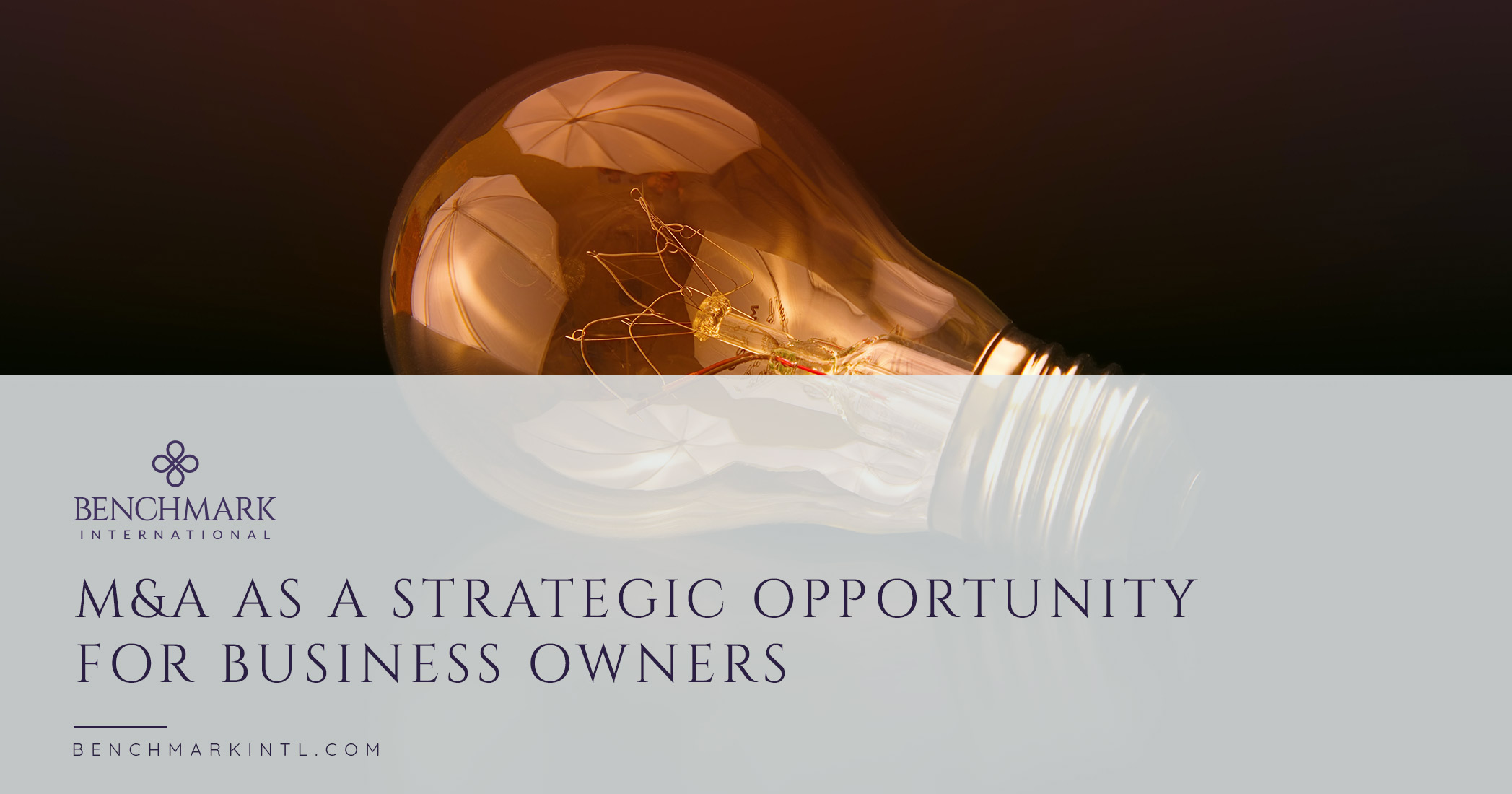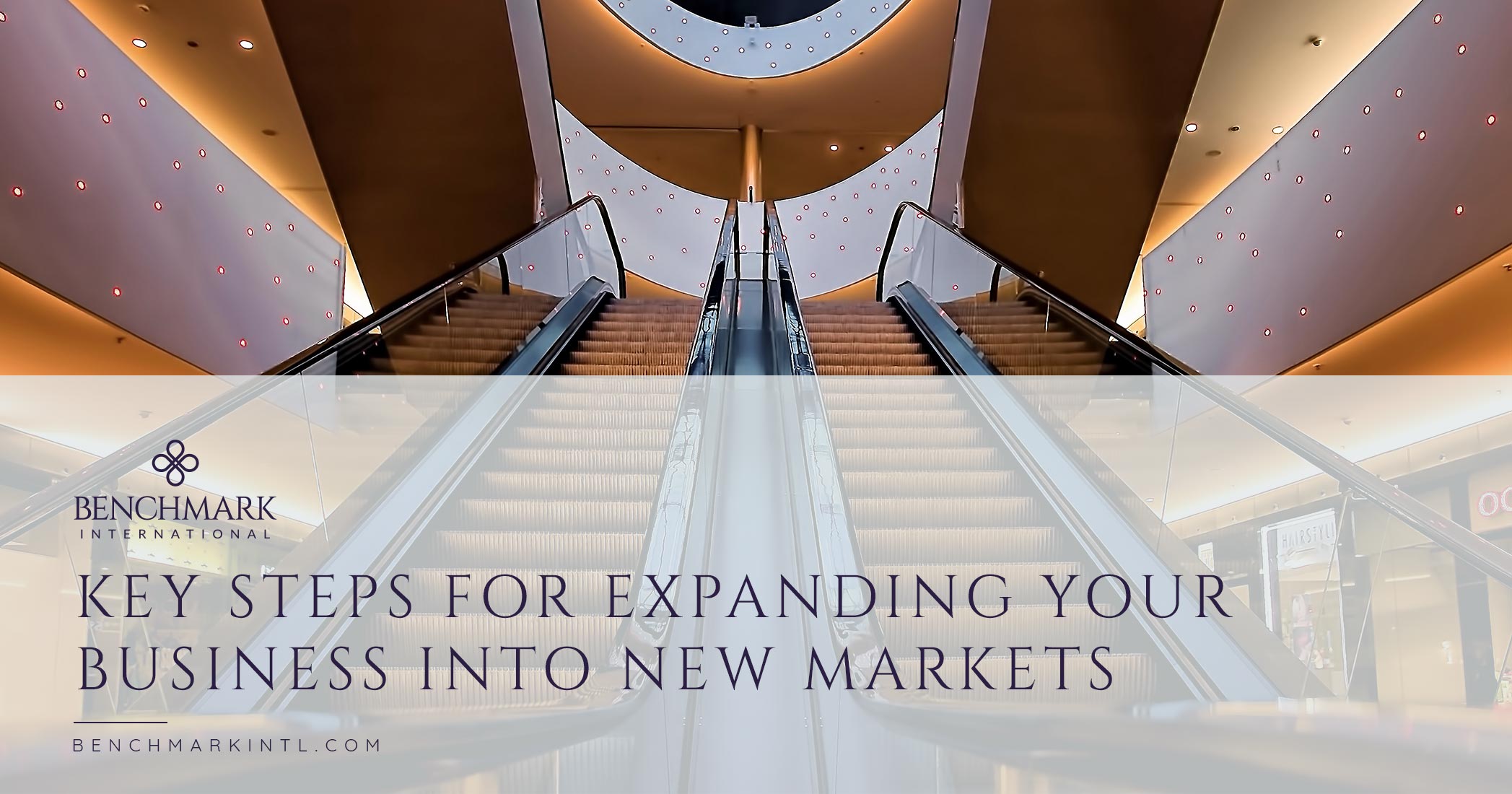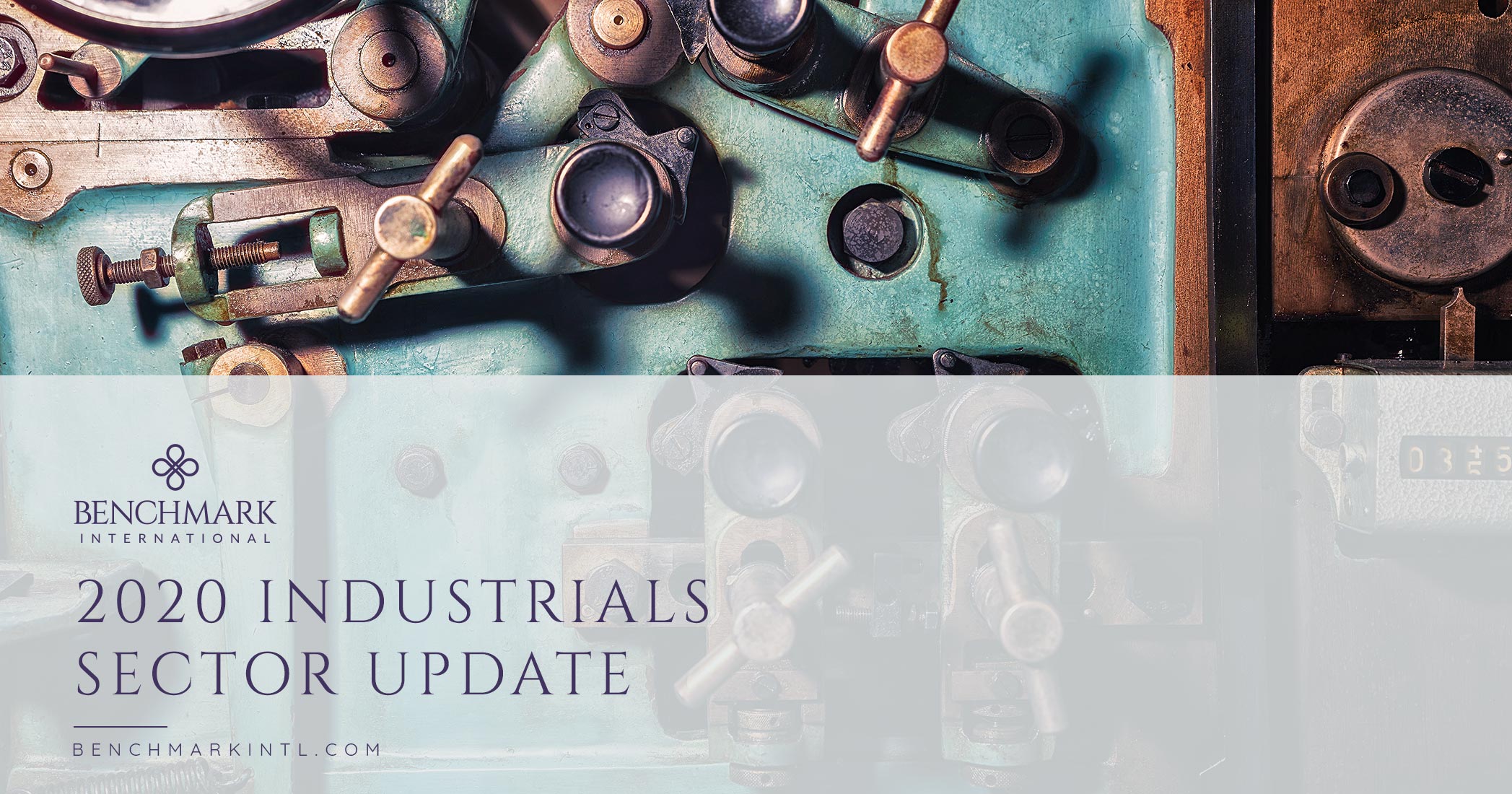As we get into 2024, every business owner should think about ways to create growth, especially if you are considering exiting your business or embarking on retirement. So, let’s look at some things you can do to take your company to the next level.
READ MORE >>Archives
Business Growth Strategies For 2024
Don’t Miss Benchmark International’s Newest Edition of The Mark
Share this:
Benchmark International Successfully Facilitated the Transaction Between K.L. Durham Construction, DBA Performance Equipment Service and Mid-State Restoration, Inc.
Benchmark International’s K.L. Durham Construction, dba Performance Equipment Service, a San Antonio, Texas-based company that is a leader in the provision of soil stabilization and milling support services to contractors with projects in Texas, has successfully sold to Mid-State Restoration headquartered in Lakeville, Minnesota.
Performance Equipment Service serves contractors across the state of Texas, specializing in highways and city and county roads and projects for airport runways, automotive tire test tracks, and private work. The company has well over a decade of business under its belt and has emerged as the go-to contractor for milling and soil stabilization.
Midstate Companies has consistently evolved and expanded to become the industry leader in cutting-edge pavement recycling. The company provides quality transportation and pavement recycling services to its customers through environmentally safe practices. Midstate has always used cutting-edge technology/equipment coupled with industry-leading personnel to make their specialized services look easy.
Benchmark International proved value in finding a buyer with experience in the industry through its proprietary multi-medium marketing strategies. In addition, Benchmark International incorporated several campaigns with local, regional, and national associations.
Transaction Director, Amy Alonso, commented, “We understood that our client was seeking an acquirer that would provide a succession plan for the company and take care of the employees. We are excited to see that our client’s business will carry on and prosper as a result of this transaction. On behalf of Benchmark International, we wish both companies continued success.”
Americas: Sam Smoot at +1 (813) 898 2350 /Smoot@BenchmarkIntl.com
Europe: Michael Lawrie at +44 (0) 161 359 4400 / Enquiries@BenchmarkIntl.com
Africa: Anthony McCardle at +27 21 300 2055 / McCardle@BenchmarkIntl.com
ABOUT BENCHMARK INTERNATIONAL
Benchmark International’s global offices provide business owners in the middle market and lower middle market with creative, value-maximizing solutions for growing and exiting their businesses. To date, Benchmark International has handled engagements in excess of $8.25B across various industries worldwide. With decades of global M&A experience, Benchmark International’s deal teams, working from 14 offices across the world, have assisted thousands of owners with achieving their personal objectives and ensuring the continued growth of their businesses.
Website: http://www.benchmarkintl.com
Blog: http://blog.benchmarkcorporate.com
Share this:
The Increasing Adoption Of Enterprise Resource Planning And Customer Relationship Management Software
Due to the COVID-19 pandemic, there has been increased adoption of enterprise resource planning (ERP), customer relationship management (CRM), and other entrepreneurial software. In 2020, many companies accelerated their plans to begin using these systems, and the market for them remains hot, particularly for Platform-as-a-Service (PaaS) and Software-as-a-Service (SaaS) models. COVID forced most businesses to digitize their offerings in real-time as consumers began turning to online shopping and employees started working remotely—both trends that are expected to continue into the future.
READ MORE >>Share this:
Key Insights in Selling an Architecture Business
Mergers and acquisitions in each industry have their own oddities, and architecture is no different from any other in that regard. However, the following similarities always seem to rise to the top when selling a firm.
Lead Architects are the Key to the Business’ Value.
At the end of the day, like all professional services businesses, the most valuable asset walks out the door every day – and – there is nothing you can do to force them to come back the next day. Acquirers are very aware of this, and when buying architecture firms, they will take extreme measures to ensure that they will return not only the day after the deal closes but for years to come. As a result, almost every deal in this space involves broadening corporate ownership to include, typically, the most senior/valuable 10% of the firm, covering the rainmakers, the client managers, the project managers, and the most brilliant experienced architects. If the owner falls into one or more of these categories, they should expect to retain some equity and sign a multi-year employment agreement.
READ MORE >>Share this:
How Potential Tax Changes Could Impact M&A
There are several changes to tax policy on the table in the United States under the Biden administration. The administration has discussed tax increases on high-income earners at some point in the future, while the timing is yet to be determined. If you are a business owner considering the sale of your company in the next few years, you may want to speed up your timeline because waiting could mean you have to pay higher taxes if laws do change.
READ MORE >>Share this:
Supply Chain Issues Are Fueling M&A Transactions
The COVID-19 pandemic disrupted normalcy in several aspects of the world as we knew it, and one of the things hit especially hard has been the global supply chain. These supply chain problems have impacted nearly every industry and business, both large and small. Because of so much continued uncertainty in supply chains—uncertainty that is expected to last for years—business owners and executive leaders are reassessing operations and seeking paths to gain more control.
READ MORE >>Share this:
Acquiring A New 401(k) Plan In An M&A Transaction
There are basically four possible outcomes for retirement plans in an M&A deal:
- The plans of both companies are merged.
- The plan at the acquired company is terminated.
- Both plans from both companies are maintained.
- The plan from the acquired company is frozen.
So, what do you need to know if these circumstances apply to a deal that you are involved in?
READ MORE >>Share this:
Benchmark International Successfully Facilitated the Transaction Between Classic Emporium, LLC And Champion Xpress Car Wash
Benchmark International’s client Classic Emporium, DBA Rain Tunnel Car Spa, a New Mexico-based company providing vehicle wash, detailing and quick lube services, has sold to Champion Xpress Car Wash, a family-owned and operated business with multiple locations across New Mexico, Colorado, Utah and Iowa.
READ MORE >>Share this:
The Impact of U.S. Infrastructure Investment on M&A
The U.S. Senate recently passed the $1.2 trillion bipartisan infrastructure bill, titled the Infrastructure Investment and Jobs Act (IIJA), to improve the country’s roads, bridges, and utilities. The bill does face an uncertain future in the House of Representatives, where its support is more limited. Still, the Democratic Party could use the reconciliation process to get the bill passed into law.
The bill includes:
- $73 billion for electric grid and power infrastructure
- $66 billion for passenger and freight rail
- $65 billion for broadband investments
- $55 billion for water systems and infrastructure
- $50 billion for Western water storage
- $39 billion for public transit
- $25 billion for airports
- $21 billion for environmental remediation projects
- $17 billion for ports and waterways
- $15 billion for electric vehicles
- $11 billion for road safety
So, what might this all mean for M&A?
READ MORE >>Share this:
The Critical Focus On Cybersecurity In M&A Deals
The recent cyberattack on the Colonial Pipeline in the U.S. is a glaring reminder of the vulnerabilities that all industries face, as well as the costly repercussions that can be a result of such a situation. Colonial Pipeline Co. paid the hacker group $5 million to have the company released from the ransomware to restore service to the critical pipeline. This actually turned out to be a wasted $5 million. For that high price, the hackers provided the company with a decrypting tool to restore its disabled computer network. But this tool was too slow, and Colonial ended up using its own backups to restore the system.
READ MORE >>Share this:
The Current State Of Commercial Real Estate
The COVID-19 pandemic has had a negative impact on all classes of commercial real estate. Yet, it also created some new opportunities within the commercial real estate (CRE) market, such as affordable rental prices, improved digital communication and payment facilitation, as well as new opportunities for business owners and investors. And further recovery is well underway.
CRE prices fell 11% between March and May of 2020. Since July, prices increased 7%, erasing over half of those pandemic declines. With investors sitting on wealth, more investment in stocks and bonds took place, which pushed prices up and interest rates down. With inflation being a growing concern, more investors may look to commercial properties with leases that have built-in rent increases to keep pace with inflation.
READ MORE >>Share this:
Growing Business Trends For 2021-2022
Our world continues to change, and businesses must remain adaptive in order to keep pace with their competition and consumer demands. Thanks to new technologies, changing customer priorities, societal movements, and of course, repercussions from the COVID-19 pandemic, business owners can expect certain industry shifts that began leading up to 2021 to continue into 2022.
READ MORE >>Share this:
2021 Energy & Sustainability Report: Progress, Trends, And M&A
The COVID-19 pandemic revealed to the world just how unprepared entire business sectors can be when it comes to unexpected events of mass proportion, and just how delicate our global supply chains actually are. COVID has been a health crisis that impacted lives, economies, and industries. Climate-driven events and disasters occur on a more concentrated scale but have proven to be extremely costly and disruptive to multiple sectors in various geographies—a problem that appears to be growing more prevalent.
READ MORE >>Share this:
Medtech M&A On Track For Strong Second Half Of 2021
In the first half of 2021, medtech M&A deals already surpassed the total number of deals from last year, and this bustle in activity is forecast to continue through the second half of the year, as medtech companies have stockpiled billions of dollars in cash. The dollar value of deals in 2021 is also expected to far outpace that of 2020. Eleven megadeals were announced in H1, with a total deal value of around $128 billion.
Medtech M&A activity kicked off 2021 right out of the gate, with at least 10 deals announced in January alone. Companies emerged from 2020 flush with cash reserves and were ready to spend on dealmaking. The medtech sector recorded a total of 33 deals in the first half of 2021. That's up from 25 total in all of 2020. In fact, the first quarter of 2021 was the busiest for medtech M&A since 2016. While the initial rapid momentum may have slowed, the second half of 2021 should be abundant with new deals.
READ MORE >>Share this:
10 Mistakes To Avoid When Selling Your Company
Selling a business comes with its share of challenges and concerns. Many business owners do not realize just how much time and energy is required to facilitate the sale of a company and are blindsided when they embark on the M&A process. The good news is that many of the pitfalls around selling can be avoided by learning from others' mistakes, like the 10 outlined below.
READ MORE >>Share this:
HVAC: A Consolidating Market
When financial buyers think of HVAC contractors, they see an industry ripe for consolidation. The trend of HVAC consolidation started a few years ago and has not slowed down.
Throughout the United States, there are thousands of independent HVAC contractors. Financial buyers, such as private equity, see the opportunity to consolidate the independent firms to create a regional or national presence. The market is roughly a $20 billion industry that is fairly recession proof, especially throughout warmer states, such as Texas and Florida.
Private equity seeks opportunities to expand businesses through acquisition and organic growth. Once they have a foothold in the industry, they can add related services, such as plumbing services, to the roll-up strategy.
HVAC consolidations tend to be in high demand in markets that have a need for the services. Some focus on new construction, while others focus on servicing existing units that can be viewed as a recurring revenue model. The competition in the local market is key when an acquirer is looking at an acquisition. Is the HVAC target company a big fish in a small pond, or vice versa? What is the growth potential within the market? Cities and towns that are growing tend to be more attractive.
Additionally, HVAC contractors might specialize in commercial or residential services. Depending on the roll-up strategy, the acquirers might have different goals on what they are looking for in the consolidation.
The consolidation allows for a larger firm to take advantage of perks that a smaller firm might not have access to due to size or cost prohibition. For example, the roll-up might be able to build out software and accounting systems to help increase the efficiencies of the company or recruit top executives to add a level of professionalism to the company.
Having this type of option within the market allows for the seller to have options about their company’s next phase. Having a larger, growing firm complete the acquisition allows the seller and the company’s employees opportunities that the selling firm could not achieve on its own. The seller may stay on post-closing in a different capacity or retire and allow employees to step into the management role. In any case, mergers and acquisitions can be an ideal solution for companies in the HVAC sector.
READ MORE >>Share this:
What To Look For When Choosing An M&A Advisor
Selling your business is a paramount moment in your life. It’s something you absolutely want to get right so that you can extract the most value out of the deal—and so that you are protected from being swindled by a savvy buyer. It also takes a great deal of time and energy to sell a company, which can be rather difficult to spare when you are trying to focus on running a business. Most people simply do not have this time, energy, connections, or expertise that is required to put their company on the market. This is where the importance of an experienced M&A advisor comes in. By partnering with an M&A expert, they handle all the details of a deal, including due diligence, negotiations, marketing, vetting, and ensuring that you get the most value for your business. They also know how to navigate bumps in the process, and manage the expectations of all parties involved.
READ MORE >>Share this:
How Your Company Can Benefit From Cross-border M&A
Growing a company once it has reached a certain plateau of success can be challenging. Mergers and acquisitions are a powerful tool for boosting the growth of an existing company—especially cross-border M&A. As a business owner, you should consider the different ways your company can benefit from an international deal.
READ MORE >>Share this:
Why 2021 Is A Seller’s Market
A Seller’s Market Versus a Buyer’s Market
In a seller's M&A market, excess demand for assets that are in limited supply gives sellers more power when it comes to pricing. Such demand can be generated and galvanized by circumstances that include a strong economy, lower interest rates, high cash balances, and solid earnings. Other factors that can instill confidence in buyers—leading to more bidders willing to pay a higher purchase price—include strong brand equity, significant market share, innovative technology, and streamlined distributions that are difficult to emulate or recreate from scratch.
READ MORE >>Share this:
Benchmark International Facilitated the Transaction of CPR Plus, LLC to Allied 100, LLC
On April 30th, 2021, Benchmark International facilitated the sale of CPR Plus, LLC (serving the Greater St. Louis area) to Allied 100, LLC of Madison, WI.
The seller, CPR Plus, provides life-saving skills training to more than 100,000 individuals for close to 30 years in the St. Louis area. Their comprehensive and convenient CPR training courses are accredited by the American Heart Association and administered by friendly instructors with extensive experience.
Share this:
Benchmark International's Gregory Jackson Named CEO Of The Year
In the GAMECHANGERS (ACQ5) 2021 GLOBAL AWARDS, Gregory P. Jackson, CEO of Benchmark International, has been named CEO of The Year in the area of Corporate Finance.
The ACQ is a leading corporate news publication serving the sector since 2003, with a global audience of more than 261,000 subscribers. The GAMECHANGERS (ACQ5) GLOBAL AWARDS celebrate achievement, innovation, and brilliance, recognizing the world's most outstanding organizations and professionals.
Share this:
M&A Expectations After The Covid-19 Pandemic
It’s no surprise that the COVID-19 pandemic slowed M&A deal activity overall in 2020. According to data from PitchBook, more than 2,000 transactions closed for a value of $336.8 billion in Q2 of last year. That represents a 41 percent decline in the number of deals from Q1. Yet, deals did pick up in the second half of the year, which is likely to continue, as businesses are poised for improved economic conditions that leave COVID-19 in the rearview mirror.
READ MORE >>Share this:
10 Factors That Drive Business Value Beyond Revenue
The value of a company extends beyond the amount of revenue it generates. As a business owner, you should be monitoring the value of your company at all times, but it is especially important if you are considering exiting or retiring within the next several years, or even up to a decade from now.
Company valuations are based on far more factors than just financial statements and multiples. The process involves the forecasting of the future of the business based on several key value drivers. Sometimes these can be sector-specific, but there are many core drivers that apply to any type of business, as outlined below.
READ MORE >>Share this:
Can I Put My Business On The Market Even Though I'm Not Actively Looking To Sell?
Maybe you’re not sure if you are ready to sell your business, but you’re curious about what you could learn if you put it on the market. You can always put your company on the market at any time, but you should understand the right way to do it, and everything that you need to consider.
READ MORE >>Share this:
Accelerating SaaS Growth With A Strategic Partner
Strategic partnerships can be game-changers for SaaS (Software as a Service) companies. Sales revenue is clearly of vital importance, but it takes more than just those numbers to make things happen on a larger scale. Relationships are the bedrock of business. If you are looking to drive growth, a strategic partnership can be a very powerful tool to help your company increase its audience, build upon the brand, and tap into new markets. All of this, in turn, can prop up your sales team and boost your overall growth.
READ MORE >>Share this:
Why You Should Consider Private Equity
How Private Equity Works
Private equity firms raise financing from institutions and individuals and then invest those funds into the buying and selling of businesses. Once a pre-specified amount is raised, the fund closes to new investors and is liquidated. All of the fund’s businesses are sold within a set timeframe that is typically less than ten years. The more successfully a PE firm’s funds perform, the better its ability to raise money in the future.
PE firms do accept some limitations on their use of investments under fund management contracts, such as the size of any single business investment. Once the money has been committed, investors have nearly zero control over its management, unlike a public company’s board of directors.
The leaders of the companies within a private equity portfolio are not members of the PE firm’s management. Private equity firms control its portfolio companies through representation on the boards of those companies. It is common for a PE firm to ask the CEO and other business leaders in their portfolios to invest personally. This offers a way to ensure their level of commitment and motivation. In return, the operating managers can get significant rewards that are linked to profits when the company is sold.
With large buyouts, PE funds usually charge investors a fee of around 1.5 to 2 percent of assets under management, plus 20 percent of all profits (subject to achieving a minimum rate of return). Fund mostly profit through capital gains on the sale of portfolio companies.
How Private Equity Improves Value
READ MORE >>Share this:
Gamestop, Robinhood, And Drama On Wall Street
The free online trading app known as Robinhood has proclaimed to be “on a mission to democratize finance for all.” It was intended to open up the Wall Street stock market to the average American for investment “on their own terms,” with more easily digestible financial information readily available to novice investors. The app was designed to “let the people trade” and make the financial system more accessible for everyone, until things took quite a turn, all due to a fledgling brick and mortar video game retailer known as GameStop.
The amateur traders using Robinhood became pitted against the hedge fund honchos when they started buying up options and shares of GameStop (GME), enlarging those bets and also making large trades of other stocks, such as AMC Entertainment, Tootsie Roll, and BlackBerry.
How It All Happened
Professional hedge fund investors had been short selling shares of GameStop, essentially borrowing shares of stock to sell, and then buying them back later so they can return them. This lets them profit if the stock price drops (betting that the company will fail). If the stock does not continue to fall, investors are forced to cover their position or buy more stock to minimize their losses.
READ MORE >>Share this:
2021 M&A Outlook
The Beginning of the End
The turbulent year of 2020 is finally in our rearview mirror. While so many lives have been lost and everyday life is still far from normal, effective vaccines for COVID-19 are being distributed, offering hope for a near-term end to the disruption we’ve endured for the past year.
Markets have begun to respond with optimism for the highly anticipated return to normal, but we’re not at the finish line quite yet. Mass distribution of the vaccine will take time, and people and businesses are still suffering as the virus is spreading at record-high levels and restrictions are being reinforced. This means that, yes, our world remains suspended in a state of uncertainty, but we have good reason to believe that the global economy will continue to recover, and mergers and acquisitions will lead the recovery. Research indicates that 53 percent of US executives plan to increase M&A investment in 2021. Some sectors have fared rather well during the pandemic. But how well—and how quickly—the overall economy recovers will depend on factors such as virus containment, fiscal and monetary policy, and inflation.
Virus containment remains the main priority for economic recovery to succeed. However, there are other possible risks to market performance. A lack of adequate policy support could occur due to concerns about mounting government debt. The technology conflict between the US and China is likely to continue even under a more traditional Biden administration, and the impacts are expected to take years to manifest. The decisions made by the two countries will affect regional economies and the businesses that operate within them. Other geopolitical factors could also shift investor attention away from recovery, but they are considered rather unlikely at this time.
READ MORE >>Share this:
Why Choose An M&A Firm Over An Industry Expert?
Many business owners believe that enlisting an expert in their industry is the right way to go when selling their companies. But if you want to rake in the most value for your business, there’s a better way.
There is no question that mergers and acquisitions are complicated and subject to constantly changing market conditions and industry trends. An industry expert might know plenty about a particular industry, but they are not experts on selling and buying businesses. A mergers and acquisitions firm is.
READ MORE >>Share this:
M&A As A Strategic Opportunity For Business Owners
It is not uncommon for a company acquisition to be viewed as a simple transaction that means transferring the business from one owner to another. But rather than just allowing the business to simply carry on as is under new leadership, a merger or acquisition should be viewed as a solid strategy to boost the company’s overall health, productivity, and bottom line. While M&A transactions can serve as great solutions for exit strategies, they can be so much more than that. M&A should be regarded as a powerful tactical opportunity.
Often times, M&A deals are considered to be a way to get out and cash out with instant gratification. But what else might be possible when a deal is carefully crafted to deliver sustainable returns and support a powerful legacy for the business in the long-term? M&A done right can translate into great success for a company and, ultimately, its leadership.
READ MORE >>Share this:
2020 M&A In The Global Sports World
In early 2020, there was plenty of optimism for investment opportunities and growth in the sports sector prior to the COVID-19 pandemic, which has since caused disruption in nearly every sector around the world. Financial uncertainty has been a large factor in addition to issues surrounding player contracts and broadcasting rights. Mergers and acquisitions activity in the global sports world has experienced a downward trend but there is hope on the horizon.
Italian Football
Amidst COVID-19 delays, Italian football (calico) has had its share of off-the-field matters this year. In August, the Italian club A.S. Roma announced the completion of a takeover by Texas-based Friedkin Group: an 86.6% stake in for €591 million, a large decrease from the previously agreed upon figure of €750 million prior to the pandemic. This lower price demonstrates how lost matches, sponsorship, and broadcasting income all impact the valuation of sports clubs. In light of these decreasing valuations, PE firms could be motivated to seek out bargain M&A and financing opportunities.
Italy’s Serie A has also embraced private investment. In September, its 20 clubs agreed to create its own media company financed partially by PE funds in order to better organize the sale and promotion of the league's TV rights. The move is designed to improve governance and increase revenue, especially abroad.
READ MORE >>Share this:
Post-COVID Due Diligence
No one knows for sure how much longer the COVID-19 pandemic will be affecting our lives and our businesses. But we do know that mergers and acquisitions are still happening, deal activity will pick up, and the way we approach due diligence in a post-COVID world has the power to make major differences when it comes to selling a company. While there are new obstacles to consider, there are also significant opportunities to identify and create value, and help companies outperform the market.
Real-time Data
READ MORE >>
Share this:
Grow Your Business Through A Strategic Alliance Or Strategic Partnership
- Joint Venture: When two or more parent companies form an entity together with a business objective, sharing in the risks and returns, and retaining their individual legal statuses. It can be an equal joint venture, in which both parent companies own an equal portion of the entity, or it can be a majority-owned venture, in which one partner owns a larger percentage of the company. A joint venture can help to save money, combine expertise, or enter new markets. It is not a partnership, consortium, or merger.
- Equity Alliance: When one company purchases a specific percentage of equity in another company.
- Non-Equity Alliance: When two companies enter into a contractual relationship, which allocates resources, capabilities, assets, or other means to one another.
Share this:
Printing & Packaging M&A In 2020
In the printing and packaging sectors, M&A activity has slowed since August of 2019 with around 14 percent fewer deals closing. Deal activity was strong at the beginning of 2020, and then the COVID-19 pandemic brought everything to a standstill in the spring, with activity starting to return to normal in late summer. In fact, there were 16 transactions in August, which happens to be the same number as August of 2019.
The pandemic has made it more challenging to complete deals because of social distancing and how it impacts personal relationships, but buyers have not lost their strategic focus. The packaging side of the business has shown a heightened level of interest in labels, corrugated cartons, and folding cartons. Private equity and large corporate investors remain in the game. There is increased interest in flexible packaging, but the number of these transactions has been limited by the availability of target businesses in this segment.
READ MORE >>
Share this:
2020 Automotive M&A Update
During the first half of 2020, M&A activity in the automotive industry was down from previous years due to uncertainty stemming from the COVID-19 pandemic, with cross-border deals becoming more complex. However, the pandemic also resulted in new opportunities for consolidation within the industry.
There were $11.9 billion in M&A deals, which represented a 54.8% decrease in value compared to the first half of 2019. Most investments were in the pursuit of CASE (Connected, Autonomous, Shared, Electrified) technologies. This type of tech is predicted to drive M&A through the end of 2020. Dealmakers are expected to concentrate on securing supply chains and increasing resiliency rather than expanding globally.
Global Deal Activity
The majority of deal value in volume in the first half of 2020 took place in Asia and Oceania, followed by North America. The largest automotive transaction in the first half of the year was valued at $2.9 billion, with Traton SE, a vehicle-manufacturing subsidiary of Volkswagen AG, acquiring Navistar International Corporation. Volkswagen Group China continued to strengthen its electrification strategy by making two acquisitions valued at more than $1 billion each: Gotion High-tech Co. and JAC Volkswagen Automotive Company.
READ MORE >>Share this:
2020 Financial Services Sector Update
As the world still faces the COVID-19 pandemic, businesses in the financial services sectors are preparing themselves for life after coronavirus. This includes the management of credit risk for borrowers, and turning to digital strategies to drive revenue growth.
Insurance and Innovation
The COVID-19 pandemic is forcing the entire insurance sector to implement and leverage digital platforms that enhance customer experiences as a key part of their business strategies in a transformed world in which people are working remotely and driving their vehicles less often. The pandemic has led insurance companies to implement premium relief efforts, offer payment deferral plans, and expand coverage, but these companies are also turning to more digital strategies, emphasizing online customer experiences at a time when more and more transactions occur online versus in person. Consumers are demanding new products such as cyber insurance, more modern life insurance options, and usage-based car insurance. Middle-market insurance companies have always been a bit technologically behind the big players, but they now must adopt new innovations in order to merely keep up with convenience, simplicity, mobility, and modern interfaces that customers have come to expect.
Banking and Lending
Financial institutions are in a position where they need to understand borrowers’ needs and current financial states more than ever. They must also find new ways to measure performance through the rest of 2020. They have already provided assistance to many small and mid-size businesses during the crisis, some of which will be forgiven. Loan modifications have been provided to help businesses survive, and there is likely to be some loan losses. As the economy begins to recover, banks will be able to get a better understanding of borrowers’ financial states, knowing that it will take some time for businesses to bounce back. Deciding whether to lend more credit will be a difficult decision for financial institutions, especially for harder hit sectors such as hospitality and retail. Understanding the recovery of these industries as a whole will be critical through the use of data and payment activity monitoring.
Family Offices
Family offices are private wealth management firms that serve high-net-worth individuals and their families by offering a total outsourced solution to managing finances and investments. There are nearly 2000 of these types of firms around the world, with more than half in the U.S.
These firms have typically relied on physical offices to conduct business. Now in the wake of COVID-19, a shift to virtual family offices has become a necessity during a time where remote work has become commonplace. This has been a challenge for many family offices because most simply do not have the appropriate technology and infrastructure to result in a seamless transition to a virtual office. These businesses will be forced to evolve technologically into the rest of 2020 and beyond. As outdated technology is replaced with better performing innovations, family offices will become more mobile and agile, as well as better equipped with more adequate cybersecurity. Connectivity is also a timely issue, as Millennials will be inheriting family wealth in the future and they demand immediate access to data without disruption and with more transparency. This digital transformation to virtual family offices will also allow for a leaner staff that can deploy resources more quickly.
Capital Markets
The events of 2020 have led capital markets to affect businesses in different ways. Underwriting slowed for high-yield borrowers. Mergers were put on hold. Stock markets have been up and down, and a record number of securities and their values have been exchanged. As financial conditions improve, confidence combined with cheap credit will have companies seeking liquidity to get through the rest of the crisis. Corporations have been tapping into the public debt markets at high rates. While this generated profits at the start of the recession, bonds are less likely to be issued as businesses restore their reserves and establish liquidity that will be needed into the future.
For the rest of 2020 and into 2021, investment banking associated with M&A activity will continue to be tied to the economic recovery amid a softer deal pipeline. When the economy finally bounces back, there will be opportunity for a backlog of deals, boosting advisory revenues.
Data and Private Equity
In the time of COVID-19, certain private equity trends have emerged and are expected to be here to stay. People are still paramount, but how they work has changed. Data continues to be more important to deal making to determine the areas for greatest earnings impact. Datasets will track strategic movements and metrics within companies to gauge their performance. Remote workforces will allow competitive PE firms to source key financial talent from entirely new geographic regions. Firms are also expected to outsource more of their back-office work functions and instead focus on front-office responsibilities.
Ready to Sell?
If you are a business owner who is considering making a move, our M&A experts at Benchmark International would love to discuss how we can help with the sale, exit or growth of your company.
READ MORE >>Share this:
Key Steps For Expanding Your Business Into New Markets
As globalization becomes more common in our world, many businesses are choosing to take advantage of the growth opportunities that lie in expanding into new markets. But expansion can be a significant undertaking for small and middle-market businesses, with many moving parts. As a business owner, you need to fully assess and understand the risks and rewards that expansion can present for your company. The following steps outline areas on which you should focus, and which elements of your business you should have ready in order for an effective expansion into new markets.
Impact Assessment
Before expanding your company into new markets, you must have a comprehensive understanding of what the overall impact on your business will be. Conduct market segmentation and product gap analyses to assess whether your product or service will sell in the target market and do a SWOT analysis to see how it stacks up against local competitors. You need to know if there is a need for your company and if anyone will buy what you are selling. You will also need to consider how large the market is and how long it may take to reach your target sales numbers.
READ MORE >>Share this:
The Impact Of 5G On M&A
Next-generation 5G networks are widely viewed as one of the most impactful and anticipated technological developments in current times. With super-high speeds of 100 times faster than that of 4G networks, 5G is expected to bring broadband connectivity to 10 times the wireless devices and usher society into a digital industrial revolution that will open up new possibilities, innovative applications, reduced energy consumption, and economic growth.
The Impact of the 5G Value Chain on the Global Economy for 2020-2035
- Up to $13.2 trillion of goods and services through 2035
- $2.1 trillion in GDP growth
- 22.3 million new jobs
*According to a study commissioned by Qualcomm Technologies, Inc.
When Will 5G Finally Be Available?
READ MORE >>
Share this:
2020 Industrials Sector Update
The industrials sector has had to adapt to significant disruption due to the global COVID-19 pandemic, and the challenges associated with it. While 2020 started on a very positive note with rapid growth for the global manufacturing sector, manufacturing output plummeted throughout the beginning of the year and into May due to shutdowns around the world. Output, new orders, exports, and purchases all fell to levels not seen since the 2008 recession. Many large manufacturing countries were under lockdowns into April, but restrictions were eased in May, which helped deter the overall rate of decline. In the wake of the crisis, many companies have found ways to evolve and use digital solutions to transform their business models, discovering changes that will continue to be beneficial in a post-COVID world. This adaptability is crucial to the survival and future relevance of these businesses.
Industry Highlights
- Automation and connective worker technologies have become even more important to boosting productivity.
- Migration to the cloud allows companies to be more flexible in dealing with disruptions.
- The auto manufacturing industry is growing more resilient due to greater supply chain visibility.
- For oil and gas companies, advanced digital technologies are a vital investment.
The Fourth Industrial Revolution
Industrial companies that made prior investments in digital technologies and IT infrastructure were able to operate efficiently during the earliest phases of the pandemic. The Fourth Industrial Revolution, also known as Industry 4.0, has enabled manufacturers to evolve their traditional supply chains and processes into highly interconnected systems. Leading organizations have been investing heavily in developed digital platforms specific to the industrials sector, pivoting business models towards being more software-centric. Additionally, smart manufacturing technologies are now transforming traditional manufacturing processes and paving the way into the future. More and more companies will be exploring digital technologies to enhance their flexibility and operate more innovatively. Robotics and 3D printing are among the most popular operational solutions that are expected to see continued heavy investment.
While remote work has become a relatively easy and normal option for many employees across different sectors, the industrial manufacturing sector is not one of them simply for logistics reasons. For example, machines need operators to keep them running. However, it has been demonstrated that technology can help limit the number of people needed to maintain operations.
Connected worker technologies are helping to streamline and hasten solutions. Typically, machine repairs require operators to contact service technicians, sometimes located in different facilities or at the original equipment manufacturer. Also, training new or existing workers has typically been face to face. Augmented reality is helping to eliminate in-person interaction for the purposed of repair, service and training and empowering workers to be more independent through digital on-demand access to manuals, instructions, and other resources.
While manufacturing companies tend to be more hesitant about migrating operations to the cloud, these organizations are realizing that cloud technologies enables them to move inventory, work smarter, customize products, and shift resources in much more flexible manner. The cloud is also an effective asset-performance tool that gives supervisors a remote window into facilities, production lines, and individuals.
Robotics and automation have significantly increased productivity for manufacturing processes. By replacing manual processes with automated alternatives, it helps to mitigate workforce availability challenges and reduces the impact of low-cost labor decisions.
Additive manufacturing and 3D printing continues to evolve and has shifted from the production of prototype applications to finished products. These manufacturing technologies are gaining more traction and offer efficient value chain solutions that enable on-demand production, less working capital, reduced supply chain complexity, fewer tools or parts needed, and less frequent human intervention.
The Auto Industry
Technology and connectivity is now the third most cited investment priority for the
automotive manufacturing industry. The future lies in edge computing, monitoring software, and the Industrial Internet of Things. Companies are able to collect and analyze data on site and in real time, connect applications to essential equipment, and conduct advanced monitoring and remote controls.
Another result of the pandemic for the auto industry is a need for more transparency in global supply chains. Thanks to AI, there is a shift from existing models in equipping automakers so that suppliers can use analytics to respond to changes in real time. For middle-market companies that have been known to underinvest in tech, this shift is especially important. Investment in IT infrastructure will help establish a more nimble and scalable environment, and will create more valuable data. The sequentially distributed databases of Blockchain technology are also changing supply chain management and adoption is expected to increase greatly into the future.
The Oil and Gas Sector
Digital technologies are also being adopted by oil and gas companies in order to bolster cost and operational efficiencies, improve safety, and reduce environmental impacts.
Robotics, AI, cloud solutions and Blockchain are all being used more and more to advance the industry. According to Bloomberg, oil companies are expected to spend $1.3 billion on advanced analytics alone in 2021. The big oil and field services companies with more experience aggressively adopting innovation and that are in favorable cash positions are more likely to continue investing in new tech. Human intervention is being scaled back. Maintenance procedures are being automated. Drones are being used to monitor real-time conditions and detect leaks. AI sensors are monitoring conditions such as temperature and vibration. At the same time, small and mid-size companies that were less mature coming into the pandemic are likely to focus spending on technology that helps them keep their businesses running.
Contact Us
No matter what sector your business operates within, Benchmark International is here to help. Contact us to discuss how we can help you grow or sell your business for maximum value.
READ MORE >> Benchmark International
Benchmark International  Benchmark International
Benchmark International 


